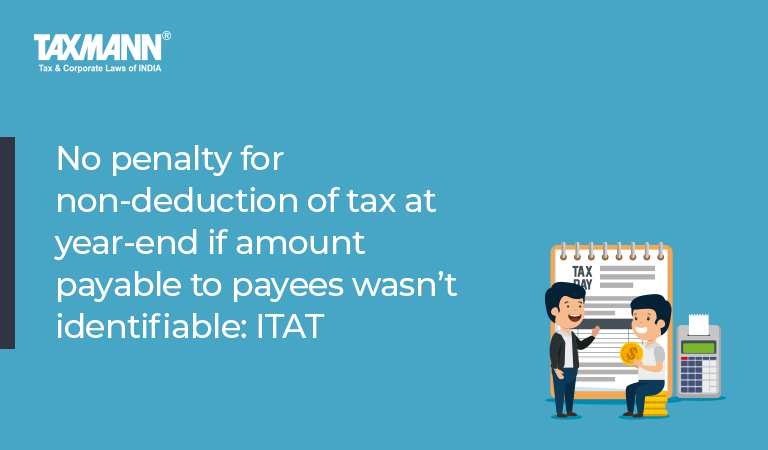No penalty for non-deduction of tax at year-end if amount payable to payees wasn’t identifiable: ITAT
- Blog|News|Income Tax|
- 2 Min Read
- By Taxmann
- |
- Last Updated on 30 July, 2022
Case Details: ACIT v. Parsons Brinckershoff India (P.) Ltd. - [2022] 140 taxmann.com 645 (Delhi-Trib.)
Judiciary and Counsel Details
-
- R.K. Panda, Accountant Member & Kul Bharat, Judicial Member
- Divyanshu Agarwal and Akarsh Gard, Advs. for the Appellant.
- Parikshit Singh, Sr. DR for the Respondent.
Facts of the Case
Assessee was a company engaged in the business of providing engineering consultancy services, supply of manpower services, and providing multidisciplinary consultancy services.
Assessee was informed by the Assessing Officer that there was a failure on part of assessee to deduct tax at the source. A show cause notice was issued by AO asking the assessee as to why penalty under section 271C read with section 274(1) should not be imposed.
Assessee explained that it was not a case of non-deduction of tax at all. The assessee had duly deducted and deposited the taxes with the government treasury in the subsequent years when the liability to pay such expenses was crystallized on receipt of invoices.
Matter reached before the CIT(A) wherein the ruling was given in favour of assessee. Aggrieved-AO filed the instant appeal before the Tribunal.
ITAT Held
The Tribunal had upheld that order of CIT(A) wherein it was held that no income had accrued to the payees and a mere ad-hoc provision was made in the books of accounts at the year-end. The existence/accrual of income in the hands of the payee is a pre-condition to fasten the liability of tax deduction at source in the hands of the payer.
In the instant case, the exact amount payable to the payees was not identifiable, and therefore, no liability to deduct tax at source arose. The mere fact that the taxes have not been deducted on the year-end provision but have been subsequently deducted and deposited upon crystallization of liability to pay the expenses will not automatically justify the imposition of penalty under section 271C.
Thus, the assessee was prevented by a reasonable cause to withhold taxes on the year-end provisions.
List of Cases Referred to
-
- ITO v. DLF Southern Homes (P.) Ltd. 2017 SCC Online ITAT 148 (para 6)
- Dy. CIT v. Telco Construction Equipment Co. Ltd. [IT Appeal No. 478 (Bang.) of 2012, dated 7-3-2014] (para 6).
Disclaimer: The content/information published on the website is only for general information of the user and shall not be construed as legal advice. While the Taxmann has exercised reasonable efforts to ensure the veracity of information/content published, Taxmann shall be under no liability in any manner whatsoever for incorrect information, if any.

Taxmann Publications has a dedicated in-house Research & Editorial Team. This team consists of a team of Chartered Accountants, Company Secretaries, and Lawyers. This team works under the guidance and supervision of editor-in-chief Mr Rakesh Bhargava.
The Research and Editorial Team is responsible for developing reliable and accurate content for the readers. The team follows the six-sigma approach to achieve the benchmark of zero error in its publications and research platforms. The team ensures that the following publication guidelines are thoroughly followed while developing the content:
- The statutory material is obtained only from the authorized and reliable sources
- All the latest developments in the judicial and legislative fields are covered
- Prepare the analytical write-ups on current, controversial, and important issues to help the readers to understand the concept and its implications
- Every content published by Taxmann is complete, accurate and lucid
- All evidence-based statements are supported with proper reference to Section, Circular No., Notification No. or citations
- The golden rules of grammar, style and consistency are thoroughly followed
- Font and size that’s easy to read and remain consistent across all imprint and digital publications are applied








 CA | CS | CMA
CA | CS | CMA


